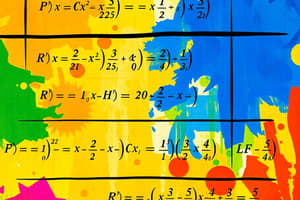Podcast
Questions and Answers
What is the derivative of a constant function f(x) = 7?
What is the derivative of a constant function f(x) = 7?
If f(x) = 3x^2, what is the derivative f'(x)?
If f(x) = 3x^2, what is the derivative f'(x)?
When using the power rule, what happens to the exponent when finding the derivative?
When using the power rule, what happens to the exponent when finding the derivative?
What rule do we apply to find the derivative of composite functions?
What rule do we apply to find the derivative of composite functions?
Signup and view all the answers
If f(x) = 5x^3 + 2x^2 - 7x, what is the derivative f'(x)?
If f(x) = 5x^3 + 2x^2 - 7x, what is the derivative f'(x)?
Signup and view all the answers
What is the product rule used for?
What is the product rule used for?
Signup and view all the answers
What does the quotient rule help us with?
What does the quotient rule help us with?
Signup and view all the answers
How do we determine maxima and minima points of a function?
How do we determine maxima and minima points of a function?
Signup and view all the answers
Which application involves pinpointing values for optimal results?
Which application involves pinpointing values for optimal results?
Signup and view all the answers
In which situations are derivatives crucial for capturing instantaneous rates of change?
In which situations are derivatives crucial for capturing instantaneous rates of change?
Signup and view all the answers
What does the fundamental theorem of calculus help us relate?
What does the fundamental theorem of calculus help us relate?
Signup and view all the answers
Study Notes
Differentiation: Derivative Rules and Applications
In calculus, differentiation is one of its core concepts. It involves finding the slope of the tangent line to a curve at any given point along it. This process can be quite complex, especially when dealing with more challenging functions like polynomials, rational expressions, logarithms, trigonometric functions, or exponential functions. To tackle these, we rely on certain derivative rules to simplify our calculations. These rules help us find the derivative in various situations without having to do all the work from scratch each time. We'll explore some common ones here.
Basic Derivative Rules
Let's start with some basic differentiation rules which apply to various function types:
- Constant Rule: If f(x) = k where 'k' does not change with respect to x, then its derivative f'(x) = 0.
- Power Rule: For any positive integer n and nonzero constant k, if f(x) = k * x^n, then its derivative is f'(x) = n * k * x^(n - 1).
These two simple rules cover many cases where you might have only variables raised to powers or constants multiplied by them.
Chain Rule
The chain rule comes into play when we encounter composite functions; functions within other functions. In such scenarios, the general formula for the derivative of a composition g(u) composed of another function u(x), denoted as F(x) = g(u(x)), applies. Specifically, F'(x) = g'(u(x)) * u'(x). This means that when taking the derivative of a composite function, you need to multiply the derivatives of both functions involved together.
Product Rule
When dealing with products of two functions, say f(x) and g(x), their product rule states that (f(x) \cdot g(x))' = f'(x) (\cdot) g(x) + f(x) (\cdot) g'(x). Essentially, this indicates how much each factor changes relative to the total rate of change.
Quotient Rule
For quotients of two functions, say g(x)/h(x), the quotient rule dictates that (g(x)/h(x))' = [g'(x) (\cdot) h(x) - g(x) (\cdot) h'(x)] / [h(x)^2]. Again, this shows how one part affects the whole rate of change compared to the other parts.
Now let's move on to discussing applications of derivatives.
Maxima and Minima
A key application of differentiating functions deals with identifying locations where the value of a function changes rapidly due to local extrema (maximums or minimums). By setting the derivative equal to zero (critical points) and analyzing the sign of the second derivative (derivative of the first derivative), we determine whether the function reaches its maximum or minimum at those critical points.
Optimization Problems
Derivative analysis plays a pivotal role in solving optimization problems. Here, we seek values of input parameters that result in maximum or minimum output responses. A typical example would involve maximizing profits based on production costs. Differentiation helps us pinpoint exactly what values lead to optimal results.
Rate of Change
Understanding the rate of change of quantities over time or under varying conditions is crucial across multiple fields. Whether tracking disease transmission rates, predicting stock market trends, or estimating energy consumption growth, derivatives serve as valuable tools to capture instantaneous rates of change—a vital parameter whenever speed matters.
Integrals
Finally, there's the relationship between integration and differentiation known as the fundamental theorem of calculus. Basically, this says that integration undoes differentiation (at least for nice enough functions): [∫_a^b {F'(x)} dx= F(b) - F(a)]This equivalence allows us to compute integrals using antiderivatives (functions whose derivatives are the original functions) rather than evaluating Riemann sums directly.
With these insights into derivative rules and their applications, you now have the power to navigate real-world challenges requiring quick assessments or precise quantification of phenomena.
Studying That Suits You
Use AI to generate personalized quizzes and flashcards to suit your learning preferences.
Description
Explore the fundamental concepts of differentiation in calculus, including derivative rules for various function types like polynomials, rational expressions, logarithms, trigonometric functions, and exponential functions. Learn about common rules like the constant rule, power rule, chain rule, product rule, and quotient rule. Discover how derivatives are applied to find maxima and minima, solve optimization problems, analyze rates of change, and understand the relationship between integration and differentiation.




